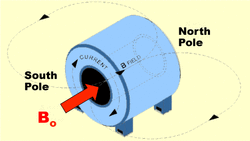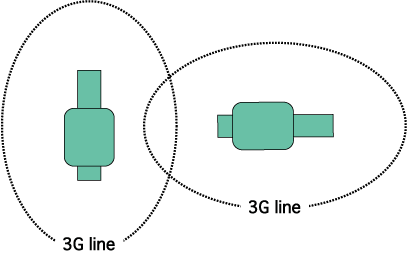
South and North poles
For convenience and standardization (but really no other good reason), the patient table end of a scanner is usually taken to be the South pole and the far back "service" end the North pole. The direction of the Bo field is therefore from front (−Z) to back (+Z) along the bore of the scanner. However, this is an entirely arbitrary choice and could vary by installation.
In the past clinical scanners had relatively large fringe fields, and when two or more scanners were sited near each other in a facility, some consideration had to be given to the polarity of each magnet. In these situations magnetic fringe fields and interactions were minimized by configuring the magnets so that the unlike poles faced each other. In the modern era with self-shielded scanners, this is not a significant issue for most clinical sites. However, with very high field (7+ tesla) human and animal scanners now clustered together in research facilities, pole orientation may still be a planning consideration.
In the past clinical scanners had relatively large fringe fields, and when two or more scanners were sited near each other in a facility, some consideration had to be given to the polarity of each magnet. In these situations magnetic fringe fields and interactions were minimized by configuring the magnets so that the unlike poles faced each other. In the modern era with self-shielded scanners, this is not a significant issue for most clinical sites. However, with very high field (7+ tesla) human and animal scanners now clustered together in research facilities, pole orientation may still be a planning consideration.
Advanced Discussion (show/hide)»
For a single scanner it generally doesn't matter which end is the north pole, or whether Bo goes from front to back or from back to front. The only exception might be when EKG gating is used. As described in a later Q&A, the recorded EKG waveform is altered by the presence of ionic flow in the descending aorta, a phenomenon known as the magnetohydrodynamic (MHD) effect. The direction of Bo will affect the nature of this EKG artifact.
The situation may be more complex when the close siting of multiple magnets is planned. Regardless of magnet polarity, additional considerations should be given when magnets are side by side in adjacent bays. Below are variations of a two-magnet installation. In the first example, the magnets are parallel and there is no interaction. In the second case the 3G (0.3mT) fringe lines overlap, representing a potentially adverse field-field interaction that may compromise the homogeneity of both magnets.
Related Questions
Which way does the main magnetic field point in an MR scanner?
Which way does the main magnetic field point in an MR scanner?


